Another Side of Paris – Changes in Morality

- SUBSCRIBE
- ALREADY SUBSCRIBED?
BECOME A BONJOUR PARIS MEMBER
Gain full access to our collection of over 5,000 articles and bring the City of Light into your life. Just 60 USD per year.
Find out why you should become a member here.
Sign in
Fill in your credentials below.
 If we go back in time, Paris will offer an interesting discovery. The years before WWII reveal a greater freedom and tolerance than that of many other places at the time. Sexual tolerance was a given in Parisian attitudes, including the freedom to be openly homosexual. One’s choice of partner was a private matter.
If we go back in time, Paris will offer an interesting discovery. The years before WWII reveal a greater freedom and tolerance than that of many other places at the time. Sexual tolerance was a given in Parisian attitudes, including the freedom to be openly homosexual. One’s choice of partner was a private matter.
Vita Sackville West, an author from London, embarked on a passionate liaison with Violet Trefusis who was married to a British army officer. Vita darkened her hair and put a stained bandage around her head to look like a sailor. (Bandages were a common sight in Paris at the time.)
In Paris, they felt a sense of freedom, like a tonic or a breath of fresh air. For Vita, she finally felt the euphoria of living with a kind of defiance of every policeman they passed. “There was no abatement,” she said, “in my passion for the freedom of that life.” And it could only happen in Paris.
Looking back now, we can identify a number of famous women who called Paris their home and who lived a lifestyle they chose. A brief list would include those mentioned plus Natalie Barney Djuna Barnes, Hilda Doolittle and Bryher Ellerman, Romaine Brooks, Margaret Anderson, Gertrude Stein and Alice B Toklas, Sylvia Beach, Nadia Boulanger, Renee Vivian and the beloved author Colette.
The life of Bryher Ellerman is interesting. She was the daughter of a wealthy ship owner in England but was desperately interested in getting married traditionally so she could leave her father’s home and domination. She made a deal with American writer-publisher Robert McAlmon who married her for a fee. Then, in Paris, Bryher lived the lesbian life with her friend and lover Hilda Doolittle, known simply as HD. As a woman of wealth, she supported Djuna Barnes and was responsible for aiding McCalpine’s Contact Press which published Gertrude Stein’s The Making of Americans.
 More recently, Janet Flanner, using the name Genet, wrote for the New Yorker which allowed her to promote Paris as a cultural center. Her column, ‘Letters From Paris’ was widely read. Genet was successful and lived the last years of her life in a Paris suite at the famous and elegant Hotel Ritz.
More recently, Janet Flanner, using the name Genet, wrote for the New Yorker which allowed her to promote Paris as a cultural center. Her column, ‘Letters From Paris’ was widely read. Genet was successful and lived the last years of her life in a Paris suite at the famous and elegant Hotel Ritz.
Equally important was The Little Review, published in Paris by lesbian (former) lovers Margaret Anderson and Jane Heap. Reading Anderson’s Biography is well worth the effort.
But while Paris factions met at different places, such as Gertrude Stein’s rue de Fleurus home, the also met at Nathalie Barneys. Here they would perform, dance or sing their favorite songs, learn about art and befriend each other. The salon was also visited by men but mostly because of their contribution to the arts of the day. At 20 rue Jacob, one could meet many of the literati of the day including, Romaine Brooks, Renee Vivien and the writer Colette. Natalie translated a number of Greek pets and traveled to the Greek island of Lesbos, where she and Renee purchased houses trying to establish a Sapho poetry school. Eventually Barney returned to Paris to further her interest in Sapho.
 Sylvia Beach of Shakespeare and Company lived for many years with Adrienne Meunier. They each owned book stores and invited writers and poets to give lectures or soirees in their home and stores. Close to Sylvia Beach were Ezra Pound and James Joyce. It was also Sylvia who arranged for American writer Sherwod Anderson to meet Gertrude Stein. That meeting resulted in an introduction by Anderson of Ernest Hemingway. He often attended her Saturday Night gatherings where one could meet ‘everyone who was anyone.’
Sylvia Beach of Shakespeare and Company lived for many years with Adrienne Meunier. They each owned book stores and invited writers and poets to give lectures or soirees in their home and stores. Close to Sylvia Beach were Ezra Pound and James Joyce. It was also Sylvia who arranged for American writer Sherwod Anderson to meet Gertrude Stein. That meeting resulted in an introduction by Anderson of Ernest Hemingway. He often attended her Saturday Night gatherings where one could meet ‘everyone who was anyone.’
One can add the name of music teacher Nadia Boulanger who had Aaron Copeland as a pupil. There was also Bernice Abbott, a talented photographer and Claude Cahun who photographed many of the noted lesbians. But best known around the world, aside from Gertrude Stein and Alice B Toklas, was probably Colette; one of France’s best loved writers. Her works include a study of sexuality entitled The Pure and the Unpure which deals with a wide range of sexual incarnations. Her work deals with domestic life of women working in a man’s world. She is admired as a bourgeois Bohemian.
 Colette wrote of her lesbian affairs but she was a woman who also offered aid to her Jewish friends. During the war she turned her husband’s home in St. Malo into a hospital for the wounded. She was awarded the Legion of Honeur in 1920.
Colette wrote of her lesbian affairs but she was a woman who also offered aid to her Jewish friends. During the war she turned her husband’s home in St. Malo into a hospital for the wounded. She was awarded the Legion of Honeur in 1920.
She wrote many important books but achieved notoriety as the author of Gigi which was made into a popular film starring Maurice Chevalier, Louis Jourdan and Leslie Caron. Colette died in Paris in 1954 and was interred at Pere Lachaise Cemeterie after a state funeral.
Photo 1, Vita Sackville-West, by E.O. Hoppé [Public domain], via Wikimedia Commons
Photo 2, Janet Flanner and Ernest Hemingway [Public domain], via Wikimedia Commons
Photo 3, Sylvia Beach, Adrienne Monnier and James Joyce, [Public domain], via Wikimedia Commons
Photo 4, Colette, Agence de presse Mondial Photo-Presse [Public domain], via Wikimedia Commons
More in French history, French sex, gay sex in France, history, Paris history, same sex marriage, sex, sex in France


